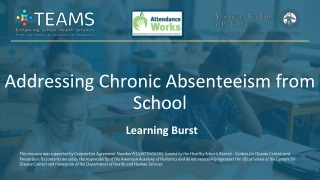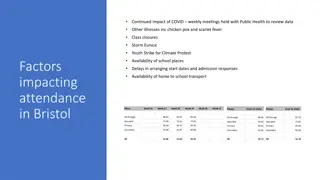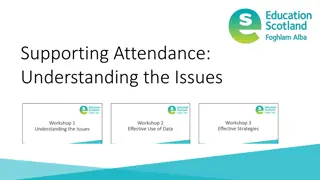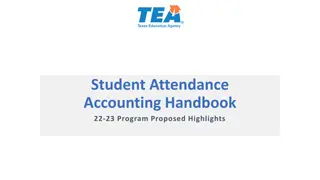
Understanding the Significance of School Attendance for Academic Success
Discover why school attendance is crucial for student achievement, the implications of chronic absenteeism, and the impact on academic performance. Learn about the role of TDSB attendance counselors in addressing attendance issues and providing support to students and families.
Download Presentation

Please find below an Image/Link to download the presentation.
The content on the website is provided AS IS for your information and personal use only. It may not be sold, licensed, or shared on other websites without obtaining consent from the author. If you encounter any issues during the download, it is possible that the publisher has removed the file from their server.
You are allowed to download the files provided on this website for personal or commercial use, subject to the condition that they are used lawfully. All files are the property of their respective owners.
The content on the website is provided AS IS for your information and personal use only. It may not be sold, licensed, or shared on other websites without obtaining consent from the author.
E N D
Presentation Transcript
Attendance Matters Aliza Shupac, MSW, RSW TDSB Social Worker & Attendance Counsellor
Problematic Attendance *Ministry requirement: 197 Instructional days. At-Risk Attendance when students miss between 5%-10% (from 10- 20 days per year ) Chronic Absenteeism is prolonged absence exceeding 10% a school year (20 or more days per year). Just one or two days a month. Truancy is consistent failure to attend school and the term used by the TDSB during court proceedings. Truancy charges are typically made when children are absent over 15% of a school year (30 or more days per year). Satisfactory Attendance: misses 5% or less of class. (10 days missed or less).
Why Does Attendance Matter? *Research shows that children suffer academically when they miss as few as 10 days or more per year (5% or over) *That can be just one or two days a month.
Attendance Matters.. Most students with Absenteeism rate of greater than 10% ( Chronic Absenteeism ) were below the provincial standard in EQAO Mathematics assessment * High Absenteeism is strongly connected to low achievement
Attendance Matters *By middle school, chronic absenteeism is highly correlated to high school dropout rates. *Lifelong habits are set as early as the young grades. *Absenteeism affects the learning of the entire classroom.
Demographics *Households headed by single mothers disproportionately affected. *Families living in poverty (transition, transportation, health care issues)= The school can help to liaise with community agencies to ensure wrap around support. *Vacations, doctors appointments (try to schedule outside of school hours).
TDSB Attendance Referrals *Referrals typically made when students miss 15% of school year (30 days or more) but also takes longer term attendance patterns into account (discretionary). (ie- 2 years of at-risk attendance ) *Automatic referral after 15 consecutive days of absence. Steps: *School attempts to support family re: attendance *Referral made to Attendance Counselor *Meeting to try and address any underlying problems- support offered. *Period of monitoring *Attendance Review Committee Hearing- Decision to press charges on parents for truancy (or decision to monitor), potential to refer to Children s Aid Society for on-going support. *Period of monitoring
*Court proceedings (The Education Act mandates that all children 16 and under attend school regularly).





















